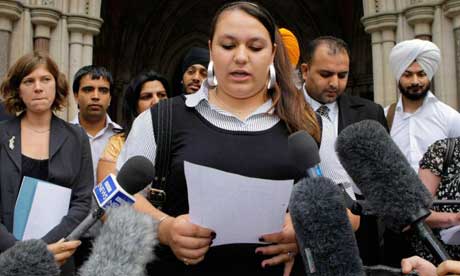
 Although a semi-frequent traveler to Canada, I must admit I have never been to the city of Vernon. I have been to the city Mt. Vernon in Ohio. Not a pretty place.
Although a semi-frequent traveler to Canada, I must admit I have never been to the city of Vernon. I have been to the city Mt. Vernon in Ohio. Not a pretty place.
Well in a week that saw the tragic death of Ishmeet Singh and the triumphant victory of Sarika Singh in the UK, I found a personal obituary of note through Google News.
It seems this past week, the Sikh community saw the passing of a “Good Citizen That Made A Difference,” Satwant Singh Dhindsa. His popularity and his commitment to service are expressed in the article.
Ishmeet Singh’s shocking and tragic death this week will be felt for some time. During his tragically short life and time in the public eye, he was as a role model and inspiration for many. He will truly be missed.

Sarika Watkins-Singh won her case in South Wales this week. The news was in many newspapers, including The Guardian, which is normally well researched. Considering the high standard of journalism that its reporters are normally held to, it’s surprising that the following statement was made so off-handedly, in a story about Sarika’s case.
Mr Justice Stephen Silber concluded the school was guilty of indirect discrimination under race relations – Sikhs are a race – and equality laws. [link]
Um, we are?! Last I heard, Sikhi was a religion. How does a religion become a race? Where did this author get this idea from?
The only remotely related idea that this statement could come from stems from the antiquated idea that Sikhs are a martial race. But even wikipedia makes clear that this idea is no longer acceptable.
Martial Race or Martial Races Theory is an ideology based on the assumption that certain ethnic groups are inherently more martially inclined than others. It was a term originally used by the British, who observed that the Scottish Highlanders were more fierce in battle than others in the British Isles, and extended this concept to India, where they classified each ethnic group into one of two categories: ‘Martial’ and ‘Non-Martial’. A ‘martial race’ was typically considered brave and well-built for fighting but was also described as ‘unintelligent’. The ‘non-martial races’ were those whom the British believed to be unfit for battle because of their sedentary lifestyles. Of late, this concept has been dismissed as Imperialistic and based on racial stereotypes. [link]
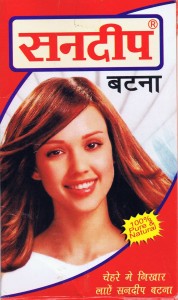 So it’s wedding season for many Panjabis in the Diaspora and one key product commonly used across South Asian groups is batnaa (the yellow mixture used on a groom/bride a day before the wedding to clear up the complexion). Guess what? Jessica Alba is now on boxes of Batnaa! When I saw this I laughed and got confused … what is going on here? I find it interesting that Alba is on the box … maybe it’s because she “looks” more South Asian than say Hillary Duff? Any other ideas?
So it’s wedding season for many Panjabis in the Diaspora and one key product commonly used across South Asian groups is batnaa (the yellow mixture used on a groom/bride a day before the wedding to clear up the complexion). Guess what? Jessica Alba is now on boxes of Batnaa! When I saw this I laughed and got confused … what is going on here? I find it interesting that Alba is on the box … maybe it’s because she “looks” more South Asian than say Hillary Duff? Any other ideas?


Also, American stars are being used to market traditional South Asian products rather than relying on Bollywood stars. Anyone else out there seen something similar in marketing other traditional South Asian products?
Ishmeet Singh, the winner of the “Voice of India” contest, passed away today after drowning in a hotel swimming pool in the Maldives. He was the only son of his parents, and was set to perform at an event in Maldives capital. Such a tragic story and such a great loss for the Punjabi community.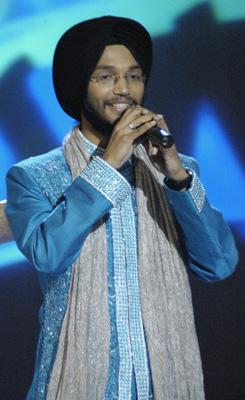 Ishmeet had been vocal about his intent to encourage Sikh youth to step out of the shadows and achieve their dreams.
Ishmeet had been vocal about his intent to encourage Sikh youth to step out of the shadows and achieve their dreams.
This talented Sikh turned out to be very humble, polite, and caring. His idea on winning rested in the ultimate sense to have faith in Waheguru wholeheartedly. He is an idol to many young Sikhs all around the world and he can inspire and motivate young Sikh men and women to succeed in life without compromising their values and traditions under any pressure whatsoever. While interviewing him, he very clearly said to me that in future he would do everything in his power to help Sikh youth with talent to step out of the shadow.
His Shabad Kirtan CD had just been released and many were hoping to see the beginning of a wonderful journey for Ishmeet. He will be greatly missed.
Previous Coverage of Ishmeet on the Langar Hall:
Some of you may have followed the case of Sarika Singh, a Welsh-Sikh student who was barred from school when the organization adopted a dress code that prohibited wearing jewelry, including religious items. Instead of conforming to the dress code or transferring schools, Singh appealed to the school. When officials refused to reverse their decision or provide exception for the kara (not an item of jewelry, but rather an article of faith), Singh sued under the UK’s anti-discrimination laws. She has been excluded from classes and from attending school for the past nine months.
Moments ago, the BBC reported that the UK’s High Court affirmed her case, stating that the dress code unfairly burdened Singh’s freedom of religious expression. Both advocates and the court expressed frustration with the school, stating that the issue had been clearly defined in U.K. statutes and case law for over 20 years. This judgment opens the door for students of all religious backgrounds; in addition to the banning of the kara, other UK (private) schools have moved to ban the crucifix, the hijab, and the yarmulke. Against this “confining” interpretation of secularism (an interpretation more common on the European continent), the UK courts have clarified the intent of the country’s inclusionary and anti-discriminatory legal framework.
We’ll continue to update with details and analysis as information becomes available.
We’re continuing our coverage on Snoop Dogg in Bollywood. And now, we’re joined by the New York Times. Some may grimace at the thought of Snoop promoting Sikhs, but he’s definitely bringing us a LOT of exposure these days. 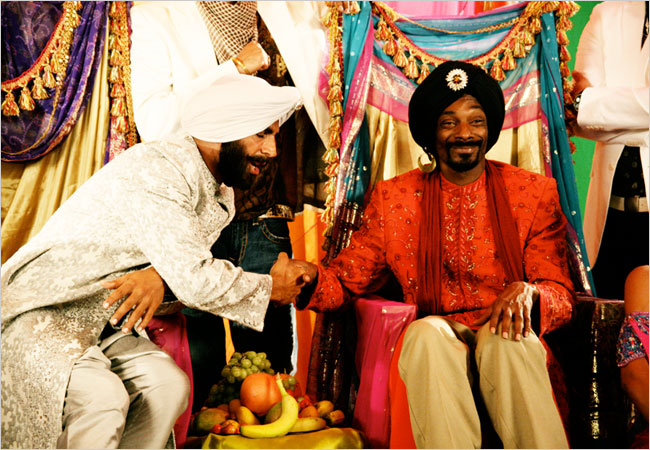
Snoop Dogg wears a Sikh turban and an ornate long coat called a sherwani in a video of the title song, which was shot this year in Chicago… “I really dig how much music is infused with the movies” in Bollywood, Snoop Dogg said in an e-mailed response to questions. “Lots of hip-hop tracks sample Indian music, and a lot of their music sounds like it was influenced by hip-hop,” he said. “We’re putting together something real big” in India, that will include collaborations, live shows and “more movies with some of my Bollywood homies.” [link]
Mewa Singh predicted that Snoop’s collaborative song with Bollywood would become the hottest new track with bhangra teams and Punjabis in the diaspora. It’s already taking over the airwaves in India, which is sort of a break through since hip hop has only been popular amongst the young, urban crowd there until now.
“I’m coming to take over Bollywood,” Snoop Dogg promised during the video shoot. “I’ve never been able to come over there and do shows for you all, but now I’m going to come and do shows,” he said in a clip that the video’s promoters put on YouTube. “This is just the beginning.” [link]
Ever wondered what Snoop thinks of you?
A recent decision of the British Columbia Human Rights Tribunal highlights some complex clashes within the Sikh community. The B.C. Human Rights Tribunal dismissed a complaint by two members of the Canadian community who were denied membership in a Burnaby gurdwara because of their caste.
But it’s not what you think. The men who were refused membership did not belong to a caste that was historically disadvantaged, but instead, were jats. And the group who did the refusing were the historically discriminated-against Ravidassia.
Gurshinder Sahota and Sohan Shergill said they were discriminated against by the Shri Guru Ravidass Sabha Temple because they belong to a higher caste in the traditional system of social ranking than do temple members… The 900 members of the Shri Guru Ravidass Sabha Temple belong to the lowest group, Dalits, formerly referred to as “untouchables” and often considered outside the caste system altogether. Sahota and Shergill are from the jat caste, which is traditionally a land-owning class in the Punjab and now makes up much of Metro Vancouver’s Sikh community. [link]
Vancouver’s Ravidassia community celebrated the decision, affirming their right to protection from the greater Sikh community.
The decision, released this week, was hailed as an affirmation of temple members’ right to gather as a “minority within a minority,” said spokesman Jai Birdi. “Since the decision has come out, the members are feeling quite empowered by it,” he said. “They’re feeling that this really reinforces their ability to come together as a marginalized community from India to talk about their heritage and historical unresolved issues and come up with some strategies for moving forward.” He added that the complainants are welcome to attend the temple’s religious ceremonies and social programs. [link]
When I was an undergraduate, I had the opportunity to attend the World Sikh Council – North America Region‘s conference on Women in Sikhi. The conference hosted panelists and speakers to discuss three broad categories: the depiction of women in Scripture (SGGS Ji), the treatment of women in the Rehit Maryada, and future possibilities/actions for promoting gender equity. The WSC, like many Sikh institutions, was heavily male-dominated at the time, although the conference liaisons did an admirable job trying to recruit a diverse panel of women to organize, speak, and develop the program. Nonetheless, the majority of conference attendees (until the very last panel) identified as men, and there was no conversation around the agency of men as allies in the struggle for gender equity. It’s always easier to criticize than construct, and I do think the conference was an important initial step; the organizers’ hearts were in the right place, and they were certainly attempting to place women at the center of the conversation.
What I found most distressing, however, was the deep level at which the “proper role” of women in Sikhi was gendered. In emphasizing the valuation of women, most speakers and commenters focused on the following passage from SGGS Ji (p. 473):
Woman becomes his friend; through woman, the future generations come.
When his woman dies, he seeks another woman; to woman he is bound.
So why call her bad? From her, kings are born.
From woman, woman is born; without woman, there would be no one at all.
Instead of focusing on the deeper meaning of this passage — that woman is a unique and necessary partner in the faith and in humanity –, most speakers placed the significance of women solely in the context of motherhood. As a result, the impact of women’s leadership is often reduced to a single meme: woman as cultural vessel — the bearer of children (Mata) and imparter of religious knowledge and instruction. This highly gendered role and image severely limits how we conceive of the role of women, both as public figures and speakers, but also in terms of their “value-added” to society.
This recent article about a granthi in Leeds suing for unfair dismissal brought me back to the topic of granthis in general. Given Sikhi’s very clear edict AGAINST the institution of a clergy, I always found it distressing to see whole gurdwaras managed and oragnized by hired granthis. If a sangat (or gurdwara) was too big to function on seva, hadn’t it possibly grown beyond its equilibrium? I always felt uneasy about high-profile (and high cost!) guest granthis, specialized sermons, and other performance-based methods in the gurdwara. Not to mention really distressed that lecturing and sermonizing often extended services and, in my opinion, often drew away from time spent in reflection around kirtan.
It also seems, to me, that the formal establishment (and acceptance) of granthis as “ordained” disciples of Sikhi encourages the creation of a laity. In theory, shouldn’t all Sikhs be capable of organizing and leading their own services? Shouldn’t we encourage everyone to achieve the literacy and familiarity necessary to comfortably participate in shabad kirtan, ardaas, and the basic requirements of langar? In the U.S., we absolutely do not provide sufficient resources to ensure this across sangats (some sangats are notable exceptions, e.g., the Beavercreek, OH, sangat, which is completely volunteer-run with no granthis, despite a population of <50 Sikhs). If we wanted to help mobilize Sikhs to be able to run their own gurdwaras, what kind of resources would we need to provide?
I understand that once we employ granthis there’s an implicit contract and deferral to their “wisdom,” but to what extent are we eroding our own personal understanding and potential for discussion, debate, and growth within Sikhi and within our own sangats? I have heard some liken granthis to spiritual guides; I would argue, however, that SGGS Ji is our guide, the Rehit Maryada our manual, and the sangat our laboratory for refining our understanding.
What is American religious tradition and how does it influence the practice of Sikhi in the US?
Recently, the Pew Forum on Religion and Public Life surveyed nearly 36,000 people of various religions (including no affiliation/atheists) with questions about their religious beliefs. Questions addressed whether individuals believed in a literal interpretation of scripture, the strength of adherents’ belief in God or universal spirit, views of one’s religion as the one true faith, as well as social and political beliefs. More information and results of the survey can be found here.
Some think the findings expose a superficiality in the practice of faiths in the US.
“Religion in America is 3,000 miles wide, but it’s only 3 inches deep,” said Professor D. Michael Lindsay, a sociologist and religion demographer at Rice University. “The issue is not that Americans don’t believe in anything. It’s that they believe in practically everything. It’s possible for Americans to hold together contradictory beliefs at the same time.” The survey found that there are Catholics who meditate, while Lindsay said other surveys have found Protestants who pray to the Virgin Mary. [link]
 One might question this conclusion that because a person holds contradictory beliefs, it means they only superficially understand/practice their religion. It may just mean that people are trying to reconcile science, their experiences, or contradictory moral beliefs with specific tenets of their own religion. The fact that they continue to hold the belief that religion proposes despite contradictory experience or scientific finding shows faith, and in my opinion, commitment.
One might question this conclusion that because a person holds contradictory beliefs, it means they only superficially understand/practice their religion. It may just mean that people are trying to reconcile science, their experiences, or contradictory moral beliefs with specific tenets of their own religion. The fact that they continue to hold the belief that religion proposes despite contradictory experience or scientific finding shows faith, and in my opinion, commitment.
A recent French decision brings debates about multiculturalism and accommodation back into focus. France’s highest administrative court prevented the wife of a French national and mother of 3 French- born children from obtaining French citizenship based purely on her wearing of a niqab– for “insufficient assimilation” into France:
…last month, France’s highest administrative court upheld a decision to deny citizenship to Ms. Silmi, 32, on the ground that her “radical” practice of Islam was incompatible with French values like equality of the sexes. [link]
The decision received support from some French-Muslim officials who do not support women’s wearing of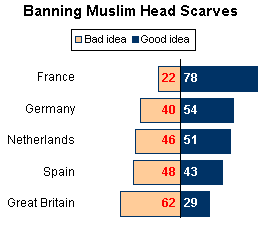 niqabs.
niqabs.
The ruling on Ms. Silmi has received almost unequivocal support across the political spectrum, including among many Muslims. Fadela Amara, the French minister for urban affairs, called Ms. Silmi’s niqab “a prison” and a “straitjacket.” “It is not a religious insignia but the insignia of a totalitarian political project that promotes inequality between the sexes and is totally lacking in democracy,” Ms. Amara, herself a practicing Muslim of Algerian descent, told the newspaper Le Parisien in an interview published Wednesday. [link]
There are major differences between the niqab and Sikh religious dress. The objection to the niqab that it’s incompatible with the French value of equality of the sexes doesn’t carry over to Sikh dress. The dastaar or pag doesn’t pose the same dilemma as both men and women may wear it, and it is not seen as an inhibition on gender equality generally.
There’s been some controversy over the upcoming film, ‘Singh is Kinng,’ [sic] starring Akshay Kumar and a host of other Indian actors I don’t know, scheduled to hit theatres on August 8th.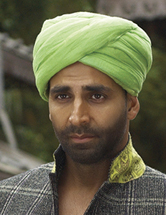
Singh is Kinng is a story about Happy Singh, a Punjabi Sikh. He is very mischievous and gets involved in a number of disastrous situations, so the villagers plan to send him to Australia to bring back his fellow villager, Lucky Singh. It is then revealed that Lucky is a underworld Don in Australia. Then, in a accident, Happy saves Lucky but still Lucky becomes paralysed. Hence, Happy becomes the new King of the Australian Underworld. [link]
For those who haven’t been following the controversy- the problem revolved around the portrayal of Sikhs in the movie (physical appearance as well as particular scenes). I haven’t seen much information on the scenes, but am assuming that they involve explicit conduct that was found offensive to screeners’ moral sensibilities. As for the the physical appearance, I can’t exactly blame critics after seeing what “Singhs” look like in the movie… (see picture on right). Um… I don’t know who tied his pag or what it’s made of or what type of fashion statement the movie is trying to make, but I don’t think any Singh I know would ever wear that.
In Ludhiana, a 29 year old woman, Hardeep Kaur, was just found dead at her in-laws house. Her brother, Harpreet Singh, informed the police that she had been frequently harassed by her in-laws about a dowry, and he alleged that the in-laws murdered her. According to Harpreet, Hardeep had just recently returned to her in-laws house under the assurance that she wouldn’t be harassed again. [link]
Considering the circumstances, it seems the assurances were false. Hardeep leaves behind a 7 year old son and a 1 and 1/2 year old daughter.
and a 1 and 1/2 year old daughter.
According to sources, Hardeep’s brother Harpreet Singh, a resident of Vishkarma colony under the Shimlapuri police station, received a call from Hira Singh’s brother-in-law Karamjit Singh informing that Hardeep had died under mysterious circumstances. He said when he went to his sister’s house, he found the house empty and the body of Hardeep was lying in a room. [link]
No arrest has been made yet, and Hardeep’s body has been sent for a post-mortem.
The race for dowry, in my opinion, is linked to the over-extravagance of weddings. Dowries used to be functional when weddings used to be functional. But as weddings have become status symbols, so has everything associated with them – the boutique/designer a bride buys her wedding clothes from, the weight of gold and diamonds, the type of transportation she and the groom use to get to the wedding/reception (apparently helicopters are in these days).
We’ve discussed before whether and how the Anand Karaj has lost its meaning to the afterparty. In cases where attention is entirely or even mostly on the materialistic aspects of the wedding, or where the result is similar to Hardeep’s, it definitely has.
![]()
A little while ago, we mentioned a census commissioned by the Punjab government and being conducted by the Punjab Agricultural University, Ludhiana, documenting the rates of farmer suicides in Punjab.
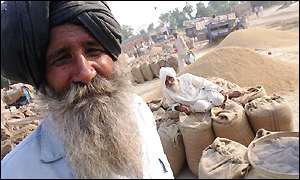 An interesting development is an independent study conducted by a group called the “Movement Against State Repression,” a Chandigarh based non-profit organization which seems to be working with patwaris in Sangrur.
An interesting development is an independent study conducted by a group called the “Movement Against State Repression,” a Chandigarh based non-profit organization which seems to be working with patwaris in Sangrur.
Inderjit Singh Jaijee, convenor of the Movement Against State Repression (MASR), has said patwaris in Sangrur district have collected information with regard to the cases of suicide by farmers. [link]
This is a positive development because the findings of the PAU can now be measured against the findings of MASR, at least in Sangrur, to ensure the truth of the figures. This is especially important because PAU is known to heavily push farmers to use pesticides which are harmful to the land, the farmers, and one factor of the recent agricultural decline of Punjab.
A movie produced by some Singhs is in theatres… if anyone catches it, give us a review!
In Los Angeles circa 1915, a little immigrant girl (Catinca Untaru) is in a hospital recovering from a fall. She strikes up a friendship with a bedridden man (Lee Pace), who captivates her with a whimsical story that removes her far from the hospital doldrums into the exotic landscapes of her imagination. Making sure he keeps the girl interested in the story he interweaves her family and people she likes from the hospital into his tale. Shot on location in 18 countries around the world, The Fall is a moving, visually sumptuous fantasy of exotic bandits, evil tyrants, dream-like palaces and breathtaking landscapes. Directed and co-written by Tarsem Singh (The Cell). Executive Producer- Ajit Singh. [link]
UPDATE: Although this post is over 5 months old, I thought I would give an update on the current case. It seems The Herald, a Catholic newspaper in Malaysia, has filed a lawsuit against the Malaysian government’s attempt to ban the usage of the word “Allah” by non-Muslims. The Malaysian Gurdwara Council (is this a real organization or a one-man show, can any of our Malaysian readers fill us in as I couldn’t find any information) has added their name to the lawsuit. Again, I revisit the question, can any one religous community claim a monopoly on its religious vocabulary? How about iconography?
———————————————————————————-
The Sikhs have a long, proud, and distinguished history in Malaysia. While Sikh traders began arriving in South East Asia, during the Mughal period, the Sikh numbers markedly increased under British imperialism.  Sikhs were often settled throughout the colonies as police men and later took a lead role in the transportation industry. Their presence and connection to Punjab has been strong throughout the past and the Khalsa Diwan Malaysia took an active role in ratifying and creating the Panthic Sikh Rehat Maryada during the early years of the 20th century. The Sikh Naujawan Sabha Malaysia remains a leading example of a diasporic Sikh organization.
Sikhs were often settled throughout the colonies as police men and later took a lead role in the transportation industry. Their presence and connection to Punjab has been strong throughout the past and the Khalsa Diwan Malaysia took an active role in ratifying and creating the Panthic Sikh Rehat Maryada during the early years of the 20th century. The Sikh Naujawan Sabha Malaysia remains a leading example of a diasporic Sikh organization.
Despite the Sikhs’ prominent standing in Malaysian society and the relatively secular nature of Malaysian Islam, it is of some note that the government recently moved to have the words “Allah” (God), “Kaabah” (Worship center at Mecca), and “Solat” (prayer) banned from non-Muslim literature and speech.
While I would guess Christian evangelism (Christians in Punjab love to call Jesus ‘Satguru’ and have ‘kirtans’ in his praise) was the main target of such legislation or appeasement towards certain political parties and groups, I am not sure what will be the impact for Sikhs due to our community’s unique lingual affinities with Islam.
Is it just me or are we seeing Giddha increasing in popularity these days?
Giddha was the folk dance of choice for our Grandmothers and Mothers. It allowed them a platform to get together with other women, and through boliyan talk openly about their daily lives. I asked my Mum if this was a form of therapy for them, and she said “yes”. It was a release for these women to be able to have this time for themselves and openly release supressed feelings in a joyful manner.
We see a great number of young women in Universities joining the “Bhangra” team and peforming these rather masculine dances at Bhangra competitions. Where is our traditional Giddha? I found this video which shows a performance by the UC Davis Giddha Squad at a competition this year. It was nice to see that these girls decided to create some uniqueness to the monotony these Bhangra competitions have began to display. Hopefully this will be a continuing trend and we will see more incorporations of Giddha for women at University levels. There is a sense of elegance and femininity that Giddha has, and which Bhangra lacks for women.
I look forward to the day when young girls are able to immerse themselves in Giddha and learn Boliyan and truly appreciate what our culture has to offer. Maybe we will see a Giddha Academy some day? I am hopeful.
With Teeyan season upon us, we can take the first step in going and attending these events in our areas. In the California we have these events scheduled annually and it’s become larger every year. Please make sure to attend if you know of Teeyan happening in your area. It would be a great way to take your Grandmothers, Mothers, Aunts, Sisters, Daughters, and Friends out to spend an afternoon together. (And it’s a great workout!)
How do you all feel about this subject? How can we begin to make a progressive change towards incorporating Giddha into the lives of younger women?
Recently I was having a conversation with a non-Sikh about names and how you can tell the gender of a Sikh individual just by looking at their name. I told her that there really wasn’t a fool-proof way of doing this since many Sikh names can be used by both men and women. However, I told her, when you see “Kaur” and “Singh” used in the name, you have a better chance of identifying the gender since it tells you if the individual is female or male, respectively. (Just to confuse her, I did mention that Singh is often also used by women). We were later joined in our conversation by another Sikh woman who basically refuted my explanation of Sikh names by telling our non-Sikh acquaintance that in fact, she and a growing number of Sikhs in our community actually don’t use “Kaur” and “Singh” at all in their name. The whole conversation reminded me of another similar discussion I happened to have with a Sikh friend of mine who, having married a non-Sikh, said that she had no intention of using “Kaur” or “Singh” in the names given to her children.
Now, while I realize that these are two unconnected conversations and I am by no means suggesting this is a trend of any sort – I do wonder how common this is and what (if anything) it means for the Panth. If, for example, my friend chooses not to raise her children Sikh, then I feel ike it is less problematic that she does not use “Kaur” and “Singh” in their names. However, it is interesting to me when people who identify themself as Sikh choose to shed this identity. I am aware that a name by itself does not necessarily establish an identity. However, I wholeheartedly believe that having “Kaur” and “Singh” bestowed upon us by our Guru was no small thing and in fact, it does establish an identity for Sikhs. By not continuing to use “Kaur” and “Singh” in the names of Sikhs, how much of our identity is being diluted? I do believe that there are enough Sikhs who are conscious of this. Many young Sikh women, including myself, who use “Kaur” as a last name now intend to keep it as a last name after they get married. This is also a significant step in solidifying one’s identity.
Thoughts on this?
It’s men like David Addington and John Yoo that give lawyers a bad name. Addington was Vice-President Cheney’s enabler. Yoo authored the infamous torture memo stating that in order to qualify as torture, pain (resulting from interrogation techniques used on detainees) had to reach a level produced by ‘death, organ failure, or permanent impairment of a significant bodily function’ (see bottom of page 38 of the memo). The memo was later withdrawn and eventually released as part of an ACLU lawsuit, forcing the Bush administration to turn over documents related to the war on terror [link]. Together, these two men are considered the chief architects of the “enhanced interrogation techniques” implemented by the Bush administration.
They were subpoenaed to testify in front of the House Judiciary subcommittee recently regarding detainee treatment, interrogation techniques and their views on Presidential power. They stuck by a strategy to reveal nothing, basically wasting the Judiciary subcommittee’s time (which Congressmen pointed out).
One thing that distresses me about their testimony and this administration is that they make a mockery of the dream that brought my parents to the US. My parents left India after 1984 seeking shelter- a place where government officials didn’t violate the fundamental rights of the people and where officials were held accountable for their actions. They came to the place where Nixon handed over incriminating tapes upon order of the Supreme Court, with the entire American army at his command. Even if their dream was romanticized before, now it’s a joke. Yet my father is as stoutly patriotic (of his adopted country) as ever.
